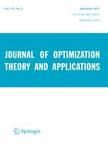版权所有:内蒙古大学图书馆 技术提供:维普资讯• 智图
内蒙古自治区呼和浩特市赛罕区大学西街235号 邮编: 010021

作者机构:Bucharest Univ Econ Studies Dept Econ Informat & Cybernet 6 Piata Romana Bucharest Romania Univ Galatzi Dept Automat Control & Elect Engn 47 Domneasca Galati Romania
出 版 物:《JOURNAL OF OPTIMIZATION THEORY AND APPLICATIONS》 (优选法理论与应用杂志)
年 卷 期:2021年第190卷第1期
页 面:151-182页
核心收录:
学科分类:1201[管理学-管理科学与工程(可授管理学、工学学位)] 07[理学] 070104[理学-应用数学] 0701[理学-数学]
基 金:European Regional Development Fund (ERDF), through the Competitiveness Operational Programme (COP) 2014-2020, priority axis 1-Research, technological development and innovation (RDI) [P_37_418, 62/05.09.2016] Romanian Ministry of Research and Innovation, CCCDI-UEFISCDI, within PNCDI III [462PED/28.10.2020, PN-III-P2-2.1-PED-2019-1198]
主 题:Optimization algorithm Game theory Smart meters Advanced tariff
摘 要:Recent advancements in the sensor industry, smart metering systems and communication technology have led to interesting electricity consumption optimization opportunities that contribute to both peak reduction and bill savings and better integration of flexible appliances (including e-mobility). In combination with advanced tariffs, there has been a promising demand side management strategy devised from different perspectives: consumers interested in cost minimization, retailers and grid operators interested in peak minimization or hybrid solutions which reduce the costs to the extent of a certain peak level. In this paper, we propose an optimization algorithm that is significantly enhanced by a Stackelberg-type dynamic nonzero-sum game in which the consumers optimize and send their 24-h consumption schedules to the electricity retailer and receive the hourly tariff rates until their savings and the Flattening Index are maximized. Thus, it has been demonstrated that the one-iteration optimization is not as rewarding as the proposed game-optimization algorithm and that the results are heavily influenced by the degree of flexibility of the appliances. The algorithm is tested and validated using a large real input dataset, recorded at 15-min interval for a period of one year from a small residential community that consists of 11 modern houses with more than 300 appliances and high flexibility in terms of shifting, and the results highlight the consumers gain, FI and peak to average ratio indicators.